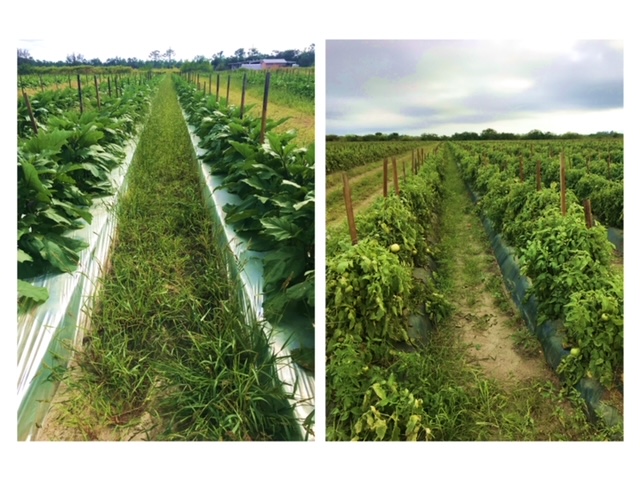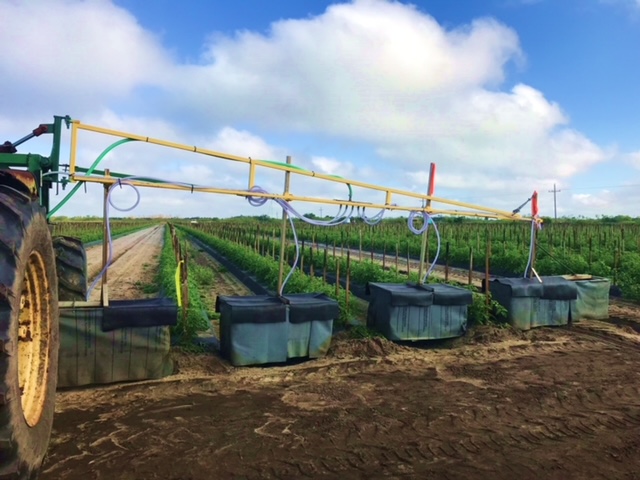By Ramdas Kanissery, Ruby Tiwari and Nirmal Timilsina
Weeds are problematic in vegetable production as they compete with crops for nutrients, water and other resources. Weeds that emerge in the spaces between the raised beds (row middles) not only serve as hosts for pests and diseases but can potentially interfere with farm operations (Figure 1). Weeds can negatively affect field sanitation measures because their seeds can spread from farm to farm by sticking to tractors, sprayers and other equipment. Effective approaches to manage weeds in row middles should be in place. Pre-emergent herbicides (also known as residual herbicides) are a helpful tool for vegetable growers looking to suppress weeds before they germinate. Applying these products requires proper strategies to get the best out of them.
Below are some ways to ensure pre-emergent herbicide applications to row middles are as effective as possible.

Photo by Ramdas Kanissery
THE RIGHT TIMING
One of the most common mistakes that leads to the failure of pre-emergent control of weeds is missing the proper application window. If pre-emergent herbicides are applied too late, they may not control weed seeds already germinated. Hence, application timing is a critical factor while utilizing pre-emergent herbicides.
Do not delay the herbicide application, as controlling weeds earlier in the season is beneficial. If the label allows it, applying pre-emergent herbicides into the row middles just before seeding or transplanting is ideal for minimizing the risk of spray drift hitting the crop. On the other hand, care must be taken not to apply too soon, as this can reduce the effectiveness of the herbicides later in the season due to breakdown in the soil by microorganisms or sunlight.
WATER-IN THE HERBICIDE
Most pre-emergent herbicides require rain or irrigation to activate after application. Adequate moisture content in the soil helps the germinating weed seeds or emerging weed seedlings readily uptake the herbicide active ingredient from the soil solution. So, ensuring proper soil moisture in row middles before scheduling a pre-emergent herbicide application improves its effectiveness.
If the row-middles are dry, a pre-emergent herbicide needs to be watered-in within a short span of its application to give it the best chance to work in the soil. However, keep in mind that heavy rainfall and flooding may adversely impact the efficacy of the pre-emergent herbicide. (See “Effects of heavy rain on pre-emergent herbicides in vegetables” in the January 2022 issue of Specialty Crop Industry.)
APPLY TO CLEAN GROUND
Pre-emergent herbicides work best when the existing weed stand is low or minimal. Existing weed growth can act as a barrier and prevent the pre-emergent herbicide from fully penetrating the topsoil layer. This reduces efficacy as weeds start to emerge from this layer. However, if you can’t apply a pre-emergent herbicide before laying the plastic mulch and transplanting, and weeds have already started to emerge in the row middles, consider tank-mixing a pre-emergent herbicide with a compatible contact herbicide such as paraquat or carfentrazone and apply as a shielded spray (Figure 2).

Photo by Ramdas Kanissery
OPTIMIZE APPLICATION
Another major factor that can help ensure the effectiveness of pre-emergent herbicides in vegetable row middles is ensuring a uniform application. Homogenous distribution of the active ingredient in the soil is crucial for maximum weed suppression as most pre-emergent herbicides bind strongly to the soil and do not move much. So, it’s important to ensure the proper calibration of the sprayer by testing the flow rate of the pump and nozzle combination and checking the nozzle angles. Additionally, the product label should be read carefully, and the correct application rates should be used.
USE PROPER ADDITIVES
Following the label’s direction, appropriate additives should be added to improve the efficacy of pre-emergent herbicides. For example, some herbicides have optimal performance at a spray solution pH of 4 to 6. If they are mixed with hard water on the farm, with a pH of 7 or 8, that may reduce herbicide effectiveness. In this case, using a pH buffer during tank-mixing could help enhance performance.
Other useful additives include binding agents or adsorption agents, specifically for improving the retention of herbicide active ingredient in the soil’s weed germination zone. Recent University of Florida Institute of Food and Agricultural Sciences (UF/IFAS) research evaluated the potential of these soil adsorption agents (such as a polyvinyl polymer) to enhance the retention of pre-emergent herbicides like flumioxazin and pendimethalin in sandy soils of Southwest Florida. Compared to using herbicide alone, the combination of herbicide with a soil adsorption agent tested in a study exhibited a significantly longer duration of weed suppression in the vegetable row middles.
ADDITIONAL RESOURCE
The latest information on weed management and other production practices in Florida-grown vegetables can be found in the UF/IFAS Extension Vegetable Production Handbook of Florida.
Ramdas Kanissery is an assistant professor, Ruby Tiwari is a Ph.D. graduate student, and Nirmal Timilsina is a master’s graduate student — all at the UF/IFAS Southwest Florida Research and Education Center in Immokalee.










